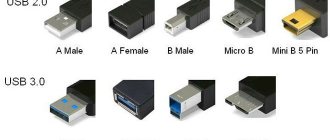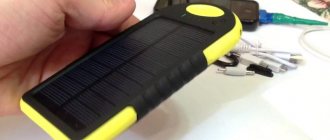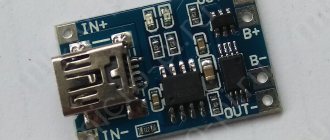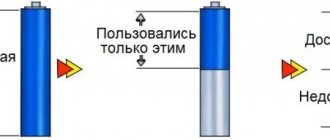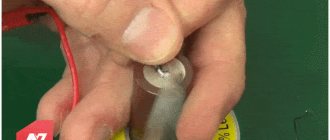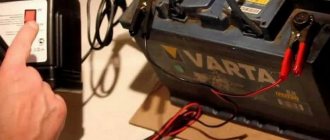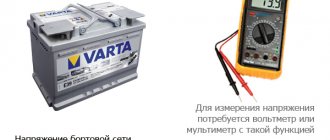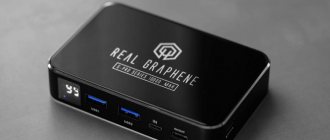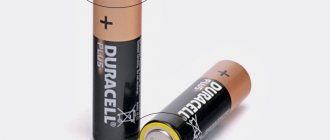Nickel-cadmium (Ni-Cd) and nickel-metal hydride (Ni-Mh) batteries are the two main types of alkaline chemical power sources for autonomous power supply of various equipment. They are similar in structure. Alkali is used as an electrolyte, and nickel oxide is used as a cathode. Nickel-metal hydride batteries also have an alternative, less common spelling: nickel-metal hydride.
Ni-cd was invented first. This technology is over a hundred years old. NI-MH began to be widely used in household devices only in the 90s of the twentieth century. The massive appearance on the market of higher-capacity NI-Mh batteries initially caused a real sensation. But then shortcomings also emerged.
Features and application of Ni-cd batteries
Compared to metal hydride batteries, Ni-Cd batteries have two main disadvantages:
- smaller capacity;
- memory effect.
The memory effect is the “remembering” of the lower discharge limit by the battery. That is, if such a battery is not completely discharged, the duration of operation in the next cycle will be less by the same amount from the full discharge to the limit that the battery “remembered”. To “reset” the memory, you need to fully charge and discharge such a battery two or three times.
It would seem that with such properties, this type of battery should go into oblivion. But this doesn't happen. Thanks to two other properties of this type of battery:
- high current output;
- ability to work well at low temperatures.
Approximately 90% of Ni Cd today is battery assemblies for power tools, children's toys, electric shavers, autonomous vacuum cleaners, medical equipment, etc. Application in the household segment (instead of conventional primary batteries) is practically reduced to zero.
Some countries legally restrict the use of Ni-Cd elements due to the toxicity of cadmium. In new devices, their place is taken by lithium-ion batteries with high current output.
Tips for optimizing battery life
The most standard advice is to completely discharge the batteries and then charge them. Although this is a treatment for the "memory effect", care must be taken in NiCad batteries as they are easily damaged by over-discharging, resulting in "pole reversal" and irreversible processes. In some cases, battery electronics are designed to prevent negative events by shutting down before they happen, but simpler devices, such as flashlights, do not.
Necessary:
- Be prepared to replace them. Nickel-metal hydride batteries do not last forever. After the resource expires, they will stop working.
- Buy a “smart” charger that electronically controls the process and prevents overcharging. This is not only better for batteries, but also uses less energy.
- Remove the battery when recharging is complete. Unnecessary time on the device means more "trickle" energy is used to charge it, therefore increasing wear and tear and wasting more energy.
- Do not completely discharge batteries to extend their life. Despite all the advice to the contrary, completely discharging them actually shortens their lifespan.
- Store NiMH batteries at room temperature in a dry place.
- Excessive heat can damage batteries and cause them to drain quickly.
- Consider using a low-battery model.
Thus, we can draw a line. Indeed, nickel-metal hydride batteries are better prepared by the manufacturer for operation in modern conditions, and proper charging of batteries using a smart device will ensure their performance and durability.
Charging ni cd batteries
One element has a nominal voltage of 1.2V. During operation, this value can vary from 1.35V (fully charged) to 1V (fully discharged). These elements have one interesting feature, which is based on the shutdown mode in the charger (if it is automatic). After gaining capacity, the voltage at the terminals decreases slightly by 50-70 mV. This jump is denoted by ΔV(delta V). The charger reacts to such a decrease and cuts off the charging current.
In practice, only medium and advanced level chargers can operate according to ΔV. And often you have to manually calculate how to charge ni cd batteries.
The charge voltage of any charge will be 1.5-1.6V per cell. But the charge current may be different. You can always see it on the charger itself (usually on the back).
The battery capacity must be divided by the charge current and multiplied by the loss factor of 1.4. For example:
1000mAh/200mA=5 hours*1.4 = 7 hours.
What current should I charge? The rated charge current is 0.1C, where C is the battery capacity. For 1000mAh the nominal current is 100mA. The charging time in this case will be 14 hours. Not very comfortable. An accelerated mode of 0.2-0.5C is almost always used. This slightly reduces battery life, but improves ease of use.
Important! The average service life of nickel-cadmium batteries is 500 charge-discharge cycles. The manufacturer claims, as a rule, UP TO 1000. Such indicators can only be achieved in ideal conditions and strictly maintaining nominal operating conditions.
NiMH recovery methods
There are several charging methods that can be used with NiMH batteries. They, like NiCds, require a constant current source. The speed is usually indicated on the cell body. It should not exceed technological standards. Charging limits are clearly regulated by manufacturers. Before using batteries, you need to clearly know what current to charge NiMH batteries with. There are several methods that are used to prevent failure:
- Charging by timer. Using time to determine the end of a process is the simplest way. Often an electronic timer is built into the device, although many devices do not have this feature. The approach assumes that the cell is charged from a known state, for example when it is completely discharged.
- Thermal detection. Determining the end of the process is done by observing the temperature of the element. Although the device will heat up when overcharging, it is difficult to accurately gauge the temperature rise since the center of the battery will be much hotter than the outside.
- Negative delta voltage detection. NiMH detects voltage drop (5 mV). Before NiMH batteries are charged, noise filtering is introduced to reliably capture this drop to ensure that "stray" sensor and other noise does not cause the charge to end.
Basic rules for charging nickel-cadmium batteries
- Batteries must be discharged before charging. Advanced chargers can do this before starting the next charge cycle, but it is possible to simply discharge using some kind of load.
- Connect the charger (or install batteries in it for domestic use) and wait until it turns off when fully charged.
- If the charger does not provide automatic shutdown, calculate the required charging time and turn it off after it has expired.
- Keep ni cd batteries in a discharged state.
Why can't you charge regular batteries?
It is not recommended to use the charger to charge tablets or any other batteries. If the case says alkaline (alkaline batteries), then you shouldn’t try.
Disposable cells have a completely different operating principle - ions flow from the electrolyte to the electrodes. Over time, their supply runs out, and then the battery runs out. If you pass current through a conventional model, the recovery process simply will not occur. For example, during operation of zinc-manganese batteries, the zinc electrode will dissolve.
The batteries are designed in such a way that the indicators of electrolytes and electrodes can be returned to the original version. When such a battery is connected to a charger, oxygen and hydrogen ions are converted from the electrolyte. The reduction process begins, where hydrogen acts as a catalyst for converting the cathode into lead, and oxygen – the anode into lead dioxide.
Features and application of NI MH batteries
The scope of application of metal hydride batteries is directly related to their properties. The maximum capacity with a minimum volume allowed them to take a place in those electronics where disposable batteries have to be changed very often. These are cameras, wireless mice and keyboards, radio remote controls, and children's toys.
There are mainly two sizes of such elements used - AA and AAA. Such elements can be used in any place where disposable batteries are used. But often this does not make economic sense (in the event that a disposable battery lasts in the device for years)
The nominal voltage ni mh of the battery is 1.2V. With a slight deviation under load, this voltage is maintained throughout the entire battery life cycle. The voltage of a disposable battery during operation gradually drops from 1.5 to 1 volt. Toi is 1.2 - the average value. This allows the battery to perfectly replace a disposable battery 99% of the time. Cases where exactly 1.5V is needed for the device to operate are rare and are often “treated” by changing the mode in the device’s “battery/accumulator” menu.
Attention! The maximum capacity (physical limit) for an AA battery is 2700mAh, for AAA - 1000mAh. If the label has a higher value and a “mysterious” name of the manufacturer, you are guaranteed to be deceived.
The memory effect when charging nickel metal hydride batteries is less noticeable than that of Ni-Cd cells. For the first few years of mass sales, manufacturers placed the inscription “no memory effect.” This inscription was subsequently removed.
The “charge after discharge” recommendation is also relevant for metal hydride batteries.
Smart devices iMax B6
In order to charge the NiMH iMax you will need a special charger as using the wrong method can render the battery useless. Many users consider the iMax B6 to be the best choice for NiMH charging. It supports the process of up to 15 cell batteries, as well as many settings and configurations for different battery types. The recommended charging time should not exceed 20 hours.
As a rule, the manufacturer guarantees 2000 charge/discharge cycles from a standard NiMH battery, although this number may vary depending on operating conditions.
Work algorithm:
- Charging NiMH iMax B6. You must connect the power cord to the outlet on the left side of the device, taking note of the shape at the end of the cord to ensure the correct connection is made. We insert it all the way and stop pressing when a sound signal and a welcome message appear on the display screen.
- Use the silver button on the far left to view the first menu and select the type of battery to charge. Pressing the leftmost button will confirm the selection. The button on the right will scroll through the options: charge, discharge, balance, fast charge, storage and others.
- Two central control buttons will help you select the desired number. By pressing the rightmost button to enter, you can move to the voltage setting by scrolling again using the two center buttons and pressing enter.
- Use several cables to connect the battery. The first set looks like lab wiring equipment. It often comes complete with alligator clips. Connection sockets are located on the right side of the device near the bottom. They are fairly easy to spot. This is how you can charge NiMH with the iMax B6.
- Then you need to connect the free battery cable to the end of the red and black clamps, creating a closed loop. This can be a bit risky, especially if the user makes the wrong settings the first time. Press and hold the enter button for three seconds. The screen should then inform you that it is checking the battery, after which the user will be asked to confirm the mode setting.
- While the battery is charging, you can scroll through the different display screens using the two central buttons, which provide information about the charging process in different modes.
Charging nickel metal hydride batteries
The charging voltage ni mh is the same as that of nickel-cadmium batteries. The charger will supply 1.5-1.6V to one element. The charge current of Ni-Mh batteries can vary from 0.1 to 1C. But any manufacturer of household batteries must indicate their recommendation for this parameter. Manufacturers' recommendation is 0.1C.
For example, for 2500mAh, the nominal charging current of Ni-Mh batteries is 250mA. Charging time with rated current is 14 hours. Same formula. Charge capacity/current, multiply the result by 1.4. With this mode, you can count on the number of cycles declared by the manufacturer. In accelerated mode the service life is reduced.
Metal hydride batteries do not tolerate:
- overheat;
- deep discharge;
- strong recharge.
Overheating can occur with a high charging current and increased internal resistance. If the charge becomes too hot, stop charging. A deep discharge occurs when the element is not used for a long time. If there is no use for a year or more, the battery will most likely have to be replaced. Excessive overcharging occurs when using a charger without a shutdown function or incorrectly calculated charging time.
Adapter Specifications
An important issue is battery life, or the overall cost over the life of the system. In this case, manufacturers offer devices with microprocessor control.
Algorithm for an ideal charger:
- Soft start. If the temperature is above 40 degrees or below zero, start with charging C/10.
- Option. If the voltage of the discharged battery is higher than 1.0 V/cell, discharge the battery to 1.0 V/cell and then proceed to fast charging.
- Fast charging. At 1 degree until the temperature reaches 45 degrees or dT indicates full charge.
- After fast charging is completed, charge at C/10 for 4 hours to ensure a full charge.
- If the voltage of a charged NiMH battery rises to 1.78 V/cell, stop working.
- If the fast charging time exceeds 1.5 hours without interruption, it is stopped.
In theory, trickle charging is a charge rate that is high enough to keep the battery fully charged, but low enough to avoid overcharging. Determining the optimal charging rate for a particular battery is a little difficult to describe, but it is generally accepted that it is around ten percent of the battery's capacity, for example, for a Sanyo 2500mAh AA NiMH, the optimal charging rate is 250mA or lower. This must be taken into account in order to properly charge NiMH batteries.
Types of chargers and charging methods
There are a huge number of chargers on sale. They implement different shutdown schemes or the shutdown is not implemented at all. They can be easily divided into subspecies based on appearance.
- Protozoa . Plugged it into the socket - the charge began, turned it off - the charge was completed. Control over charging time lies with the user. Such devices have a right to exist in order to save money. You just need to choose one that will charge each element separately. If the charge channels are paired, skew occurs. This mode shortens battery life. It's easy to distinguish. The number of LED indicators must match the number of charging channels.
- With the inscription AUTO . This inscription indicates that a timer shutdown is implemented here. Usually from 6 to 12 hours. Not the worst option. There will definitely not be a recharge. But most likely there will not be a full charge. In this case, you can select batteries specifically for this charger. But the charger will work correctly for the first 100-200 cycles.
- ΔV control . If the manufacturer has implemented this function, he will definitely write it on the packaging. If there is no inscription, the charger refers to point 2. With the presence of ΔV control, the charger is already fully automatic. Don’t forget about charging each channel separately (chargers with index 508, popular 10-12 years ago, have ΔV control, but perceive the batteries installed in it as one battery).
- With liquid crystal display . As a rule, its presence indicates that everything listed above has been implemented plus temperature control. Chargers with an entry-level display do not require programming of the charging mode and current, but they do an excellent job of their function—properly charging Ni-Mh batteries.
- Charging - combine . Larger in size than in point 4. Assume user programming of charge modes and current. If you don’t program anything in the “default” mode, charge the batteries with minimal current and turn off the charge using ΔV control. There is often a feature to completely discharge the batteries before charging to reset the memory effect.
The more functional the charger, the more expensive it is. But even in an expensive version, the cost is approximately 50 alkaline batteries. Payback comes quite quickly. A charger of this class is usually universal. And it allows you to charge, in addition to nickel batteries, also lithium-ion batteries. And also has the functions:
- capacity measurements;
- measuring the internal resistance of batteries;
- memory effect reset mode for nickel batteries.
Parallel supply of elements
Parallel charging of batteries makes it difficult to qualitatively determine the end of the process. This is because you cannot be sure that each cell or stack has the same resistance, and so some will draw more current than others. This means that a separate charging circuit must be used for each line in the parallel bank. It is necessary to establish what current to charge the NiMH by determining the balancing, for example, using resistors of such resistance that they will dominate the control of the parameters.
Modern algorithms have been developed to provide accurate charging without the use of a thermistor. These devices are similar to Delta V, but have special measurement methods to detect full charge, usually involving some kind of cycling where the voltage is measured over time and between pulses. For multi-element packs, if they are not in the same state and are not balanced in capacity, they can be filled one at a time, signaling the end of the stage.
It will take several cycles to balance them. When the battery reaches the end of its charge, oxygen begins to form at the electrodes and recombine at the catalyst. The new chemical reaction creates heat, which is easily measured by a thermistor. This is the safest way to detect the end of a process during a fast recovery.
NI-MH batteries with low self-discharge
This is a fairly new technology. The abbreviation LSD is sometimes used. What is translated from English as “low self-discharge” - low self-discharge .
Such batteries appeared on sale a little over 10 years ago and have proven themselves very well. Compared to conventional batteries, they have lower internal resistance and, as a result, higher discharge currents. Their capacity is slightly lower than that of conventional NI-MH batteries. But due to the fact that a regular battery has a self-discharge of about 10% in the first day, they are no less effective.
It is quite easy to distinguish such a battery from a regular one. There will be an inscription “ready to use” on the packaging and on the item itself, i.e. “ready to use.” Such elements are sold already charged. This is the optimal choice for amateur photography, when the task is not to take several thousand frames in one day.

